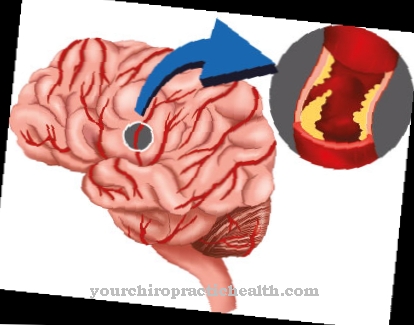The Insulinoma is a tumor of the pancreas that occurs about twice as often in women as in men. Its occurrence is classified as rare, but the insulinoma is the most common tumor of the pancreas that releases hormones directly into the blood ("endocrine"). The malignancy of insulinomas is 10%, so every ninth tumor of this type is malignant.
What is insulinoma?

© fizkes - stock.adobe.com
The insulinoma gets its name from the fact that it produces additional insulin and thus damages the body with an excess of insulin. In nine out of ten cases, the insulinoma develops as a single tumor; so-called multiple micro-adenomas are only rarely present.
In around 50% of cases, the insulinoma not only produces insulin, but also other digestive tract hormones, such as the vasoactive intestinal peptide (VIP), which is responsible for relaxing the muscles of the stomach, intestines, trachea and bronchi. The symptoms of insulinoma can also occur with the treatment of diabetes mellitus as a result of blood sugar lowering drugs.
A similar clinical picture is the so-called hypoglycaemia factitia, in which patients deliberately induce hypoglycaemia in order to get medical attention or to provoke a stay in hospital. Both diagnoses must be ruled out before determining an insulinoma.
causes
In most cases, insulinomas arise from B cells in the islets of Langerhans on the pancreas that have changed adenomatously. This degeneration produces huge amounts of insulin, which the pancreas releases directly into the bloodstream.
The ultimate cause for the development of these tumors has not yet been clarified in conventional medicine. However, insulinomas occur increasingly in the context of MEN (multiple endocrine neoplasia).
As a result of this genetically determined disease, tumors of the pancreas, parathyroid glands and pituitary glands develop at a comparatively younger age, which behave extremely aggressively and often reappear after they have healed completely.
Symptoms, ailments & signs
The insulinoma is characterized by the so-called Whipple triad. In the Whipple triad, the blood sugar level is very low with a value below 45 milligrams per deciliter. In addition, there are symptoms of severe hypoglycaemia, which can be seen as confusion, dizziness, nausea, palpitations, palpitations and tingling, and numbness.
The third sign is the rapid improvement in symptoms when consuming carbohydrates. The hypoglycaemia occurs again and again with food cravings, tremors and sweating. In the long term, there is also weight gain, since the food cravings lead to increased consumption of food. While the symptoms of hypoglycaemia can be relieved in the short term by ingesting carbohydrates, removal of the tumor must be considered in the long term.
Without treatment and removal of the tumor, consequential damage to the central nervous system can occur because the constant insufficient supply of glucose causes many nerve cells to die, which are then no longer replaced. Very often there is only a single insulin-producing tumor in the pancreas. Sometimes there are multiple tumors.
In rare cases, the tumor or tumors are also outside of the pancreas. The insulinoma itself does not cause any symptoms, only its increased production of insulin. Mostly these are benign tumors that usually do not develop metastases. However, in around ten percent of cases, malignant degeneration can occur.
Diagnosis & course
Insulinoma is suspected if symptoms of hypoglycaemia recur. In so-called hypoglycaemia, the blood sugar level is only at or below 50 mg / dl. This manifests itself in the typical symptoms that are also found in diabetes patients, such as sweating, tremors, cravings, dizziness, nausea, paleness, tiredness, concentration problems, visual disturbances, rapid heartbeat (tachycardia) and violent, often irregular heartbeat (palpitation).
Classically in medicine, the so-called “Whipple triad” is used, which combines a blood sugar value of below 45 mg / dl with the symptoms of hypoglycemia described and an improvement through infusion of glucose solutions. The longer the disease is left untreated, the higher the risk of obesity in the patient due to the anabolic effects of insulin.
This means that because of the excess insulin, the patient constantly has the feeling of having to consume food (especially carbohydrates) in order to keep his circulation stable. Diagnosis is made by fasting the patient for three days until symptomatic hypoglycemia occurs. During this time, the patient's blood is checked at regular intervals and the blood sugar, insulin and C-peptide values are recorded.
If an insulinoma is present, a very rapid drop in blood sugar and an increase in the insulin-glucose quotient can be observed. The latter should decrease in a healthy organism, because to the same extent that there is less glucose in the blood, the body should also stop producing insulin.
Complications
The insulinoma causes various complaints. These usually depend heavily on the spread of the tumor, so that a general prediction of the complications is usually not possible. However, many sufferers suffer from intense cravings and a racing heart. This can still lead to unconsciousness.
It is not uncommon for patients to suffer from anxiety or from sweating and headaches. In addition, there is often a feeling of dizziness and nausea. Those affected also complain of speech and vision disorders and, in general, a high level of adeptness. The insulinoma thus has a clearly negative effect on the patient's quality of life. Those affected also seem tired and exhausted and no longer actively participate in life.
The patient's resilience is also significantly reduced and restricted by the insulinoma. It is not uncommon for muscle cramps to occur, which can lead to restricted mobility. The treatment itself does not lead to further complications. With the help of medication or radiation, the insulinoma can be removed relatively easily. Surgical intervention can also be performed. If no treatment takes place, the insulinoma can also lead to the death of the patient.
When should you go to the doctor?
People who experience symptoms of hypoglycaemia or other signs of serious illness should consult their family doctor as soon as possible. If symptoms such as palpitations, sweats or headaches occur, a doctor must also be consulted. Recurring cravings, muscle cramps, tremors and other non-specific symptoms should also be clarified if they cannot be traced back to a clear cause. At the latest when visual or speech disorders occur or even impaired consciousness occurs, the complaints must be taken to a general practitioner. In the event of serious complications, a visit to the hospital is indicated.
People who lead unhealthy lifestyles are particularly prone to developing insulinoma. Past tumor diseases or complaints of the pancreas or parathyroid glands are also risk factors. Anyone who belongs to these risk groups must see a doctor immediately with the symptoms mentioned. Diseases of the gastrointestinal tract should be presented to a gastroenterologist or family doctor. Specialists in tumor diseases can also be called in for the complaints mentioned. After the initial diagnosis, further treatment in a specialist clinic is indicated.
Treatment & Therapy
The first step in the treatment of an insulinoma is the administration of octreotide, an artificial replica of the peptide hormone somatostatin, which slows down the release of gastrointestinal hormones, including insulin.
About half of the insulinomas respond to this treatment and the excess insulin can be stopped in this way. If the insulinoma is malignant, surgical removal, called "resection" in the medical field, is inevitable. Metastases in the liver occur in around 10 to 15% of insulinoma cases. If metastases have already formed or if the tumor cannot be operated on, the insulinoma is treated with interdisciplinary therapy together with chemotherapy and radiation therapy.
For surgical removal or efficient radiation therapy, the insulinoma is first localized as precisely as possible with the help of imaging techniques. If the tumor is already a few centimeters large, it can be localized by means of MRI, CT, or ultrasound of the pancreas. Otherwise, the insulinoma can be detected by punctual determinations of the insulin level via the portal vein, which leads past the pancreas to the liver.
If the location of the insulinoma is known, the surgical procedure can be carried out. Depending on how completely the tumor can be removed, further treatment is carried out with chemotherapy and radiation therapy.
Outlook & forecast
An insolinoma usually has a very good prognosis. In more than 90 percent of patients, surgical intervention is sufficient to remove the tumor without leaving any residue. Complications appear in the first few weeks after the operation, but subside in the long term. Occasionally, larger parts of the pancreas have to be removed in addition to the tumor. This can cause diabetes in some patients. In addition, a relapse can occur after a few years. Then another intervention is necessary.
Patients who are not completely cured should have regular follow-up visits. On the one hand, this can cause physical problems, as repeated ultrasound examinations can cause skin changes and tumors, for example. On the other hand, a chronic tumor disease represents a considerable psychological burden for the patient. In most cases, however, a positive prognosis can be made for an insolinoma.
If the tumor is detected early and the operation succeeds without complications, the patient can leave the hospital after a few days and is considered cured after a few follow-up checks. In patients with existing chronic diseases or other complaints, the prognosis depends on the constitution and the individual symptoms.
prevention
Since the causes for the development of an insulinoma have not been clarified, there are no measures that could be used to prevent this tumor.
Aftercare
After medical treatment for insulinoma, follow-up care begins. For this phase, the doctor has some useful recommendations for the patient on how the therapy can be supported. Stress reduction and physical restraint are particularly important. Chemotherapy is an extreme strain for the body, so that the patients then need a break.
Gentle sports or other hobbies that offer a little variety are also suitable as compensation. The positive influence on well-being should not be underestimated here. In consultation with the responsible doctor, those affected find out which activities are okay. The organism may be too weak for certain activities.
Those who suffer severely from the therapy would like psychotherapeutic support. This is where the patients' fears and hopes come up. The processing helps to come to terms with the situation. Contacting other people affected also improves the quality of life.
In addition, the self-help group promotes understanding. Doctors often provide useful advice for complication-free therapy and follow-up care. In order to identify any changes, the patients should keep a kind of diary in order to identify any side effects. They then clarify this at the regular check-up appointments with the doctor.
You can do that yourself
An insolinoma must always be treated by a doctor. Some self-help measures and home remedies support medical therapy.
As with other tumor diseases, care should be taken with an insolinoma. Chemotherapy in particular can put a lot of strain on the body, which is why those affected need appropriate compensation. Depending on your physical condition, it can be sport, a hobby or something else. The doctor can best answer which measures are allowed and which activities could harm the already weakened organism. Those affected who suffer from the tumor disease should also consult a therapist.Talking to a professional is the best way to deal with the fears associated with a serious illness. Other affected persons or the responsible doctor can also be asked for advice.
To enable complication-free treatment, possible side effects and interactions of the therapeutic measures should be recorded in a diary. The doctor can then adjust the treatment accordingly. After treatment has been completed, regular check-ups with the doctor are indicated. If there are signs of a relapse, the doctor must be informed immediately.


.jpg)


.jpg)







.jpg)

.jpg)
.jpg)











.jpg)